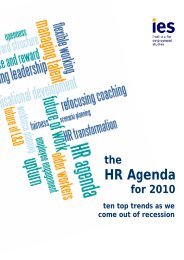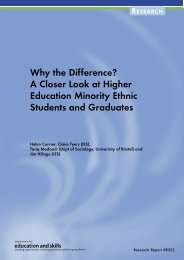Post-16 Transitions: a Longitudinal Study of Young People with ...
Post-16 Transitions: a Longitudinal Study of Young People with ...
Post-16 Transitions: a Longitudinal Study of Young People with ...
Create successful ePaper yourself
Turn your PDF publications into a flip-book with our unique Google optimized e-Paper software.
Table 4.13: Provider <strong>of</strong> help to prepare for post-<strong>16</strong> activities (multiple response)<br />
All<br />
Statemented<br />
Not<br />
statemented<br />
Special<br />
school<br />
Mainstream<br />
school<br />
N = % % % % %<br />
Parents/carers 1,226 66 64 69 60 68<br />
Other school staff 724 36 44 30 54 32<br />
School Careers Adviser 617 33 33 33 34 32<br />
Careers Service/ Connexions<br />
personal adviser<br />
387 20 22 18 24 19<br />
Friends or partner 297 17 13 21 8 20<br />
SENCO 273 13 18 10 12 13<br />
Other family member 191 11 8 13 5 13<br />
Social Worker/Services 99 4 7 2 12 2<br />
Doctor/health worker 40 2 2 2 4 2<br />
Other 40 2 2 2 2 2<br />
None 99 6 5 6 6 6<br />
Don't know /can't remember 35 1 3 0 5 0<br />
N = 1,874 1,143 611 539 1,335<br />
Note: All percentages are weighted percentages, unless otherwise stated<br />
Source: IES/MORI 2003<br />
There was little variation in the sample <strong>of</strong> young people <strong>with</strong><br />
regards to who helped them prepare for what they would do<br />
after Year 11. Some <strong>of</strong> the key differences between young<br />
people <strong>with</strong> statements <strong>of</strong> SEN and those <strong>with</strong>out relate to the<br />
help they received from school staff (more prevalent amongst<br />
young people <strong>with</strong> statements than those <strong>with</strong>out), the role <strong>of</strong><br />
friends, partners and other family members (seemingly greater<br />
for young people <strong>with</strong>out statements than those <strong>with</strong> them),<br />
and the help they received from the SENCO (young people<br />
<strong>with</strong> statements have reported more frequently that SENCOs<br />
had helped them in their post-<strong>16</strong> transition than those <strong>with</strong>out<br />
a statement). Broadly similar patterns can be observed for<br />
young people who attended special schools when compared to<br />
those in mainstream schools.<br />
There were very few major differences according to the SEN<br />
type in the help young people received to prepare for their<br />
post-<strong>16</strong> activities (Table 4.14). <strong>Young</strong> people <strong>with</strong><br />
communication and interaction difficulties and those <strong>with</strong><br />
sensory and/or physical disabilities appeared to be more<br />
likely than young people <strong>with</strong> cognition and learning<br />
difficulties, and behavioural, emotional or social development<br />
needs to have received help from school staff. <strong>Young</strong> people<br />
<strong>Post</strong>-<strong>16</strong> <strong>Transitions</strong> <strong>of</strong> <strong>Young</strong> <strong>People</strong> <strong>with</strong> SEN: Wave 2 41

















